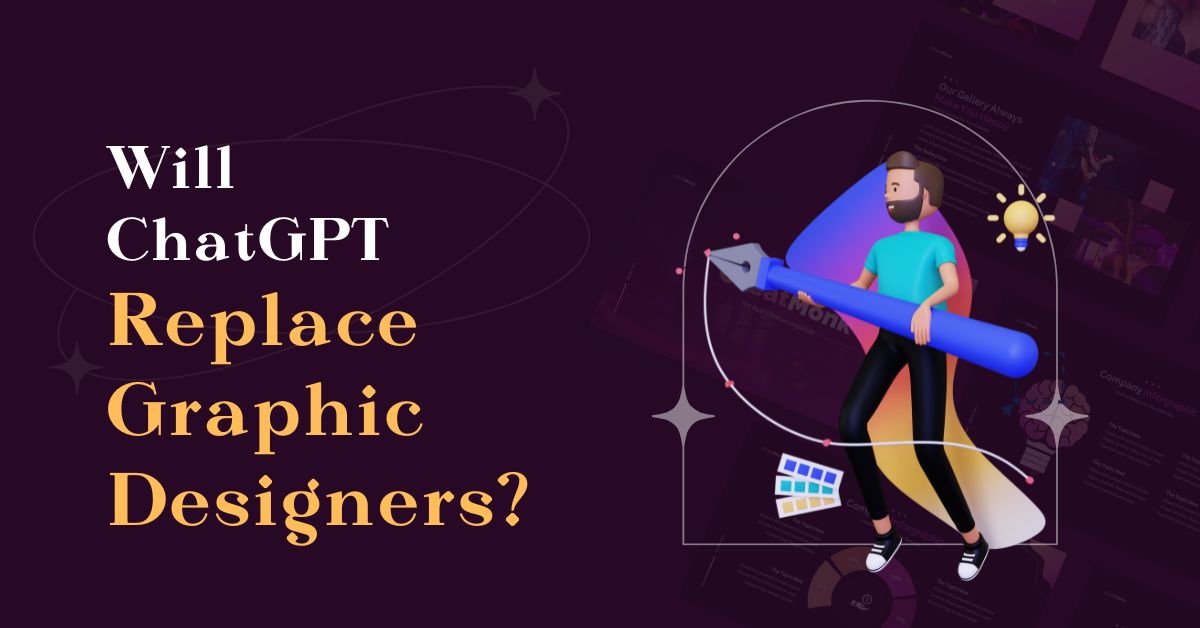
Graphic Designers have contributed to this technological revolution. As AI-powered tools like ChatGPT become more prevalent, some are concerned about the future of human graphic designers. Are you also one of those? Let’s dive into this discussion.
This post will examine whether machines will replace human designers in the industry. We will explore the benefits and limitations of ChatGPT in graphic design and how it can complement human creativity.
By the end of the post, you’ll have a clearer understanding of the role of ChatGPT in graphic design and how it can work alongside human designers.
What is the Future Impact of ChatGPT on Graphic Designers?
Will ChatGPT replace graphic designers in the future? Let’s take a look at the projected future of graphic designers. According to the U.S. Bureau of Labor Statistics, graphic designers’ employment will grow by 3% from 2021 to 2023.
ChatGPT has the potential to impact the work of graphic designers significantly. While it’s unlikely to replace human designers altogether, ChatGPT can enhance their work by automating certain tasks, generating design ideas, and improving workflows.
Here are some of the ways ChatGPT can impact the future of graphic designers:
Automating Repetitive Tasks
ChatGPT can automate repetitive tasks for a graphics designer by generating code or scripts for common design tasks, such as batch resizing or applying filters to images, based on verbal instructions. It can also assist in generating design concepts, suggesting color palettes, and even creating basic design mockups, streamlining the initial stages of the design process.
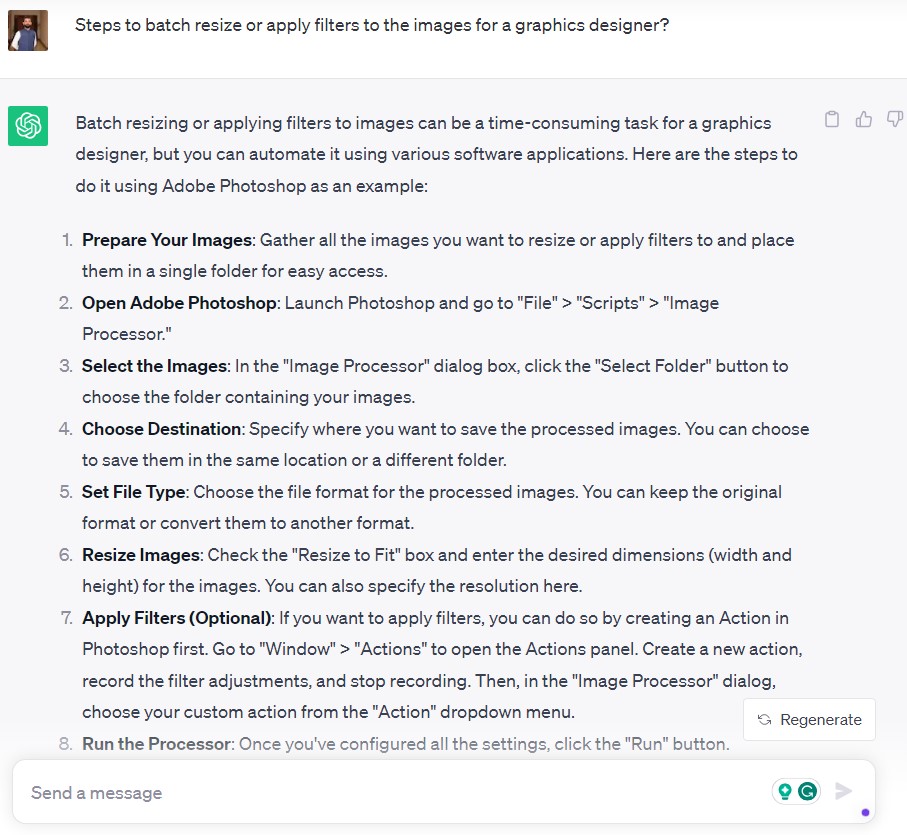
Workflow Optimization
ChatGPT can optimize the workflow for graphics designers by assisting in various aspects of the design process. It can automate repetitive tasks, such as batch image processing, generate design ideas, provide quick access to design-related information, and offer design critiques and suggestions.
Idea Generation
ChatGPT can be a valuable tool for generating ideas for a graphics designer by providing creative inspiration and design concepts. Designers can describe their project, target audience, and design goals to ChatGPT, and it can offer suggestions for color schemes, layout ideas, and typography choices and even recommend design elements or motifs that align with the project’s theme.
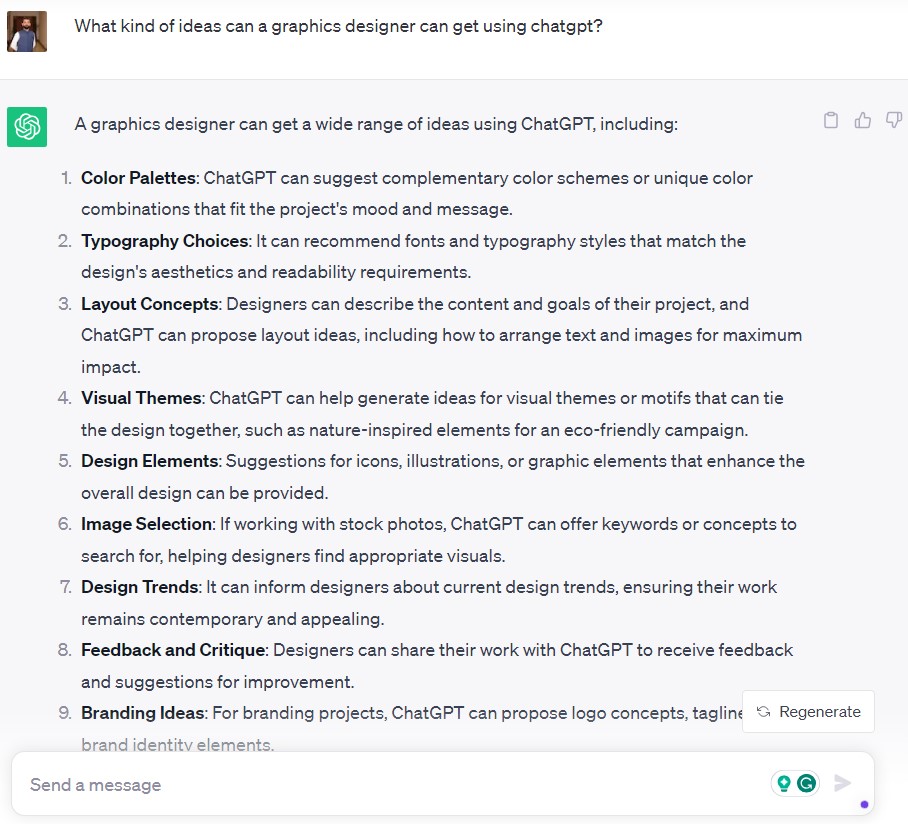
Accessibility
ChatGPT can help designers create designs that are more accessible to users with disabilities. For example, it can suggest design elements that improve readability or provide alternative text for images.
However, there are also limitations to ChatGPT’s capabilities. It’s important to note that it cannot replace the creativity, empathy, and intuition of human designers.
Design is a highly subjective field, and while AI can provide suggestions and automate certain tasks, it cannot replicate the unique perspective and creative vision of a human designer.
Why ChatGPT Cannot Replace Graphic Designers?
While AI-powered tools like ChatGPT have the potential to significantly impact the field of graphic design, it’s unlikely that they will ever replace human designers altogether. Here are some reasons why:
Creativity and Originality
Human designers possess unique creativity and originality that AI cannot replicate. Design is a highly subjective field, and designers bring their unique perspectives and experiences to every project they work on. No AI can replace the creativity and intuition that human designers bring to their work.
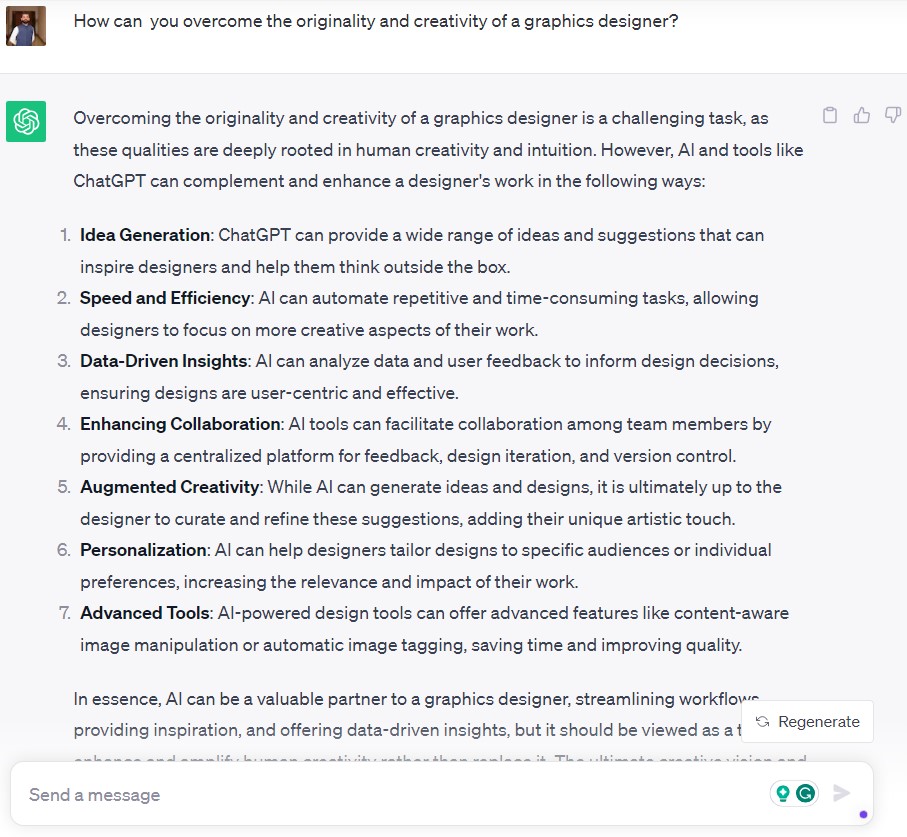
Emotional Intelligence and Empathy
Design is not just about creating visually appealing products; it’s also about understanding and connecting with users on an emotional level.
Human designers possess emotional intelligence and empathy that enable them to create designs that resonate with users. ChatGPT cannot replicate the empathy and understanding that human designers bring to their work.
Complex Problem-Solving
Graphic design involves solving complex problems and finding creative solutions to design challenges. Human designers use their creativity and problem-solving skills to create designs that meet the needs of users and achieve the goals of the project.
While AI can help with certain aspects of design, it cannot replicate the complex problem-solving skills that human designers possess.
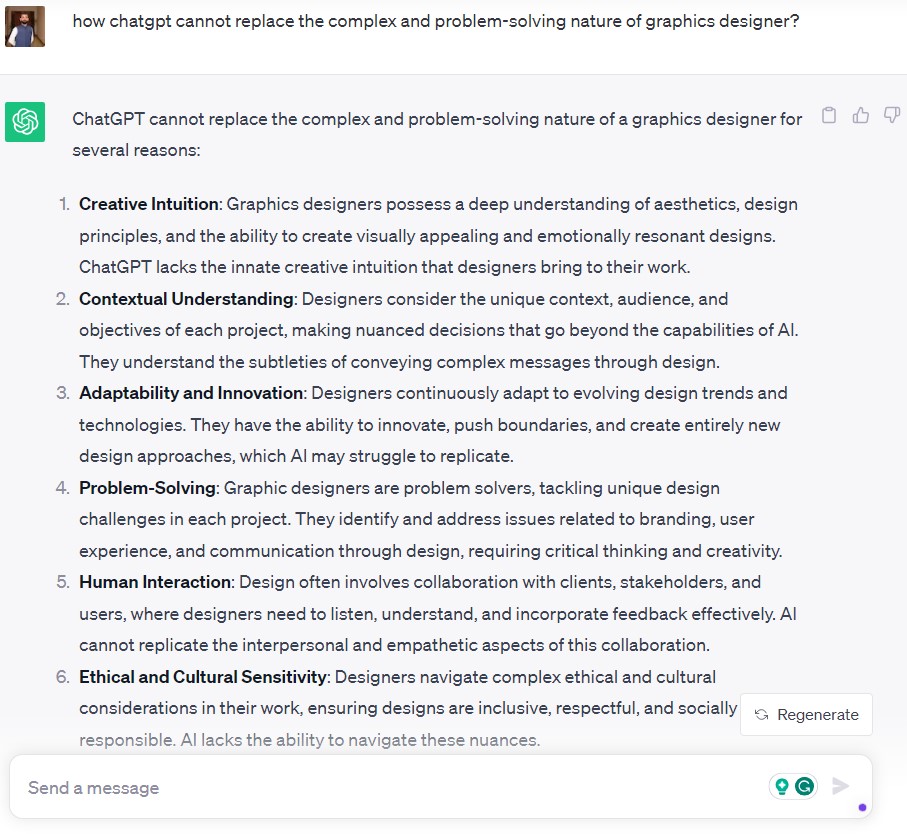
Aesthetics and Taste
Design is not just about functionality; it’s also about aesthetics and taste. Human designers possess a unique sense of aesthetics and taste that they bring to their work, which is often informed by their experiences and cultural backgrounds. AI cannot replicate the unique aesthetic sensibilities of human designers.
Collaboration and Communication
Design is often a collaborative process that involves multiple stakeholders, including clients, users, and other designers. Human designers possess communication and collaboration skills that enable them to work effectively with others and create designs that meet the needs of all stakeholders.
While ChatGPT can assist with certain aspects of collaboration, it cannot replicate the human communication and collaboration skills that are necessary for effective design.
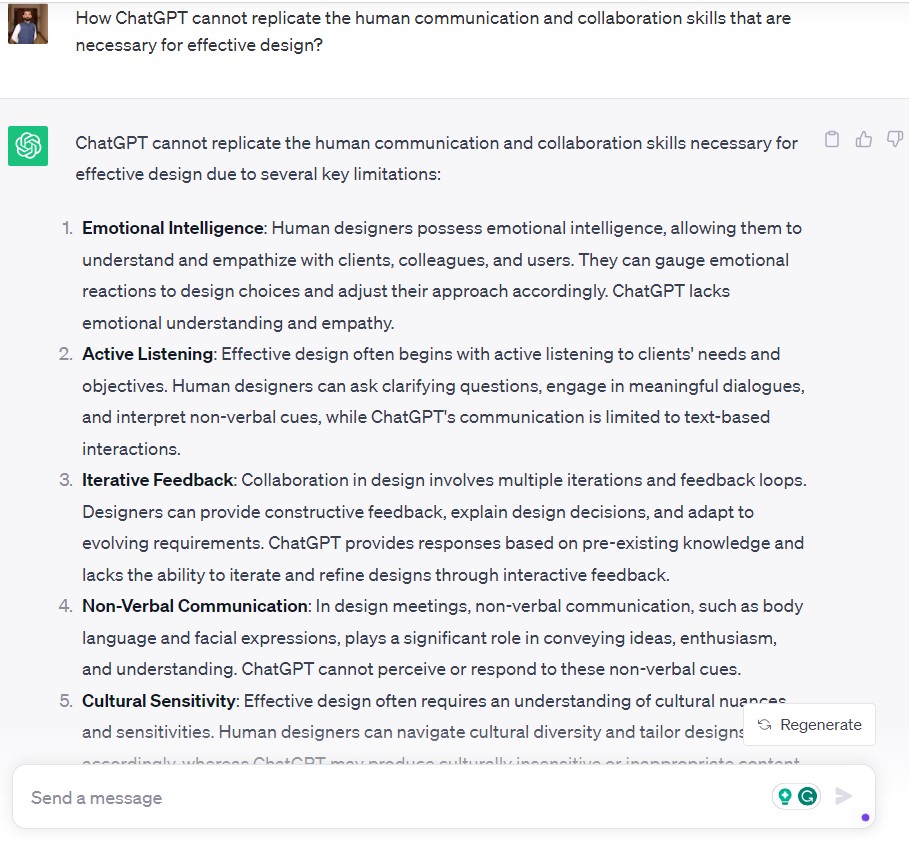
What Areas Can ChatGPT Replace Graphic Designers?
While AI-powered tools like ChatGPT cannot replace graphic designers altogether, they can assist in certain areas of the design process. Here are some areas where ChatGPT can be used to augment the work of graphic designers:
Layout and Composition
ChatGPT can assist graphic designers in creating layouts and compositions for designs. By analyzing data on user behavior and preferences, ChatGPT can provide suggestions for optimal layout and composition to improve the effectiveness of a design.
For example, ChatGPT can analyze the layout of a website and suggest changes to make it more user-friendly. Let’s have an overview of it from the ChatGPT itself:
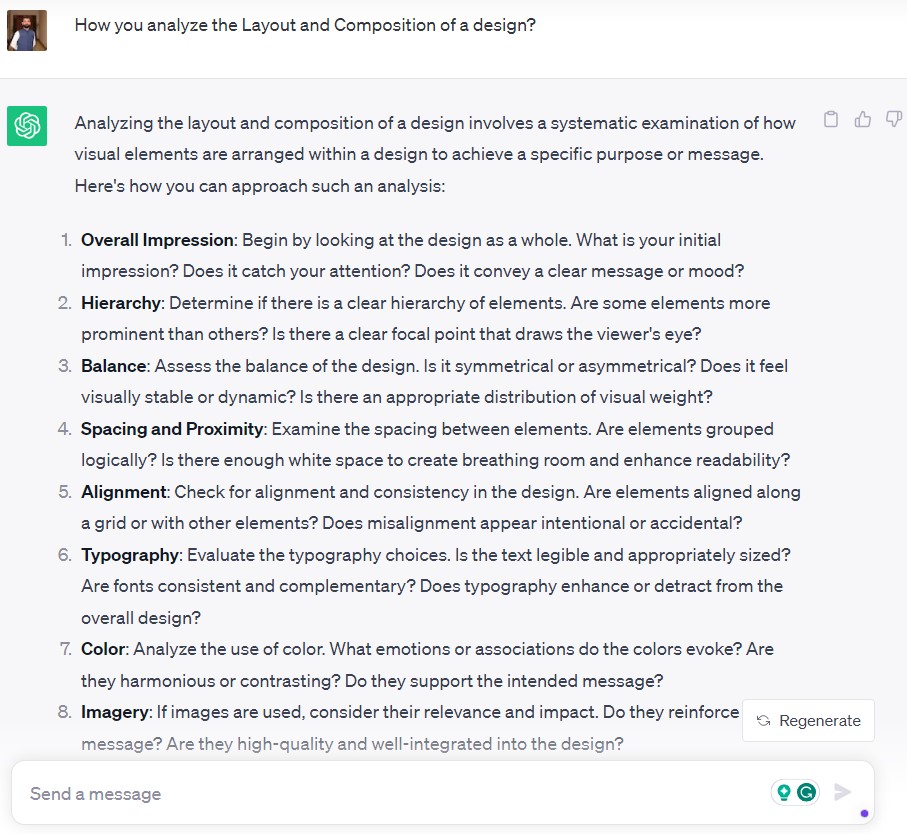
Design Automation
ChatGPT can also be used to automate certain design tasks, such as creating repetitive elements in a design. For example, ChatGPT can automatically generate variations of a logo or typography by analyzing data on user behavior and preferences.
Image Editing and Enhancement
ChatGPT can assist designers in editing and enhancing images for their designs. By analyzing data on user behavior and preferences, ChatGPT can provide suggestions for improving the quality of an image, such as adjusting brightness and contrast or removing background noise.
Data Visualization
ChatGPT can be used to create data visualizations that effectively communicate complex data. By analyzing data and creating visual representations of that data, ChatGPT can provide designers with useful insights and suggestions for presenting data in an impactful way.

Design Feedback and Critique
ChatGPT can also be used to provide feedback and critique on design work. By analyzing data on user behavior and preferences, ChatGPT can provide designers with insights on how to improve their designs and make them more effective.
What Areas Will ChatGPT Struggle to Replace Graphic Designers?
While ChatGPT can be a powerful tool to assist graphic designers, there are certain areas where it will struggle to replace the creativity and expertise of human designers fully. Here are some areas where ChatGPT will struggle to replace graphic designers:
Conceptualization and Ideation
One of the most important aspects of graphic design is the ability to conceptualize and ideate. This involves brainstorming and coming up with creative ideas for a design project.
While ChatGPT can assist in generating ideas based on data analysis, it lacks the human intuition and creativity to come up with truly original and innovative concepts.
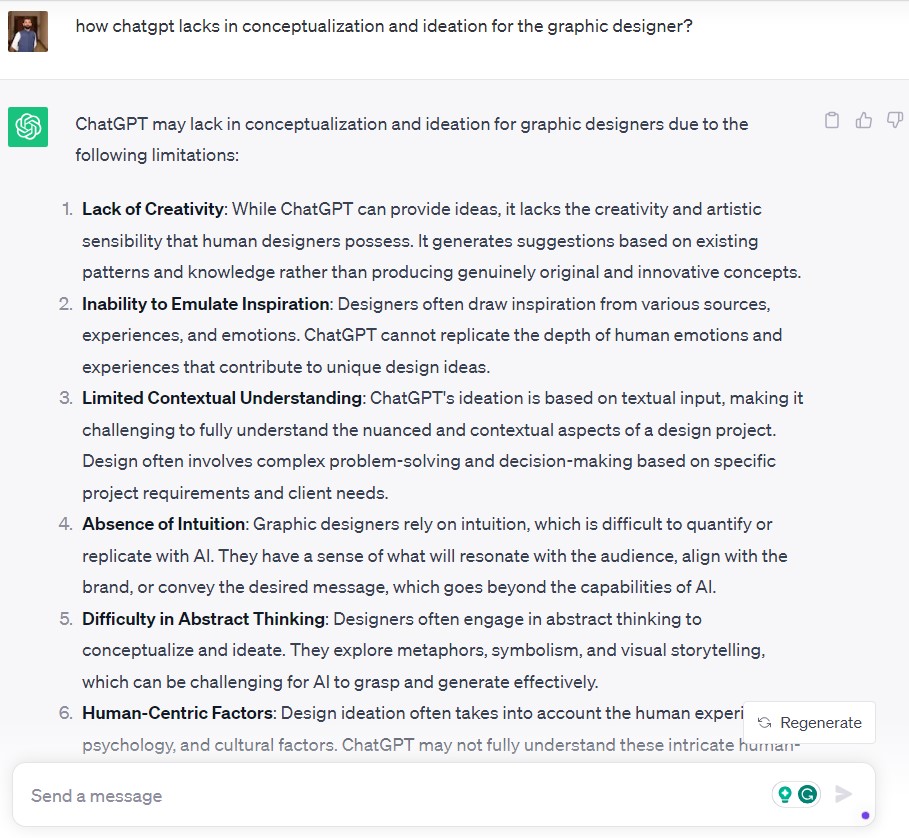
Branding and Identity
Creating a unique brand and identity is crucial for businesses to differentiate themselves from their competitors. This involves creating a brand personality, choosing a color palette, and designing a logo that represents the brand.
While ChatGPT can assist in creating variations of a logo or choosing colors based on data analysis, it cannot replace the human ability to understand a brand’s values and personality and translate that into a visual identity.
Artistic Elements
Graphic design often involves the use of artistic elements, such as hand-drawn illustrations or custom typography. These elements require a high degree of creativity and skill that cannot be replicated by ChatGPT.
While ChatGPT can generate variations of pre-existing elements, it cannot create new artistic elements from scratch.
User Experience and Interaction Design
Designing for user experience and interaction is a crucial aspect of graphic design, especially for digital products like websites and mobile apps.
ChatGPT can assist in analyzing user data to provide insights into user behavior, but it lacks the human ability to understand the nuances of user experience and design interactions that are intuitive and user-friendly.
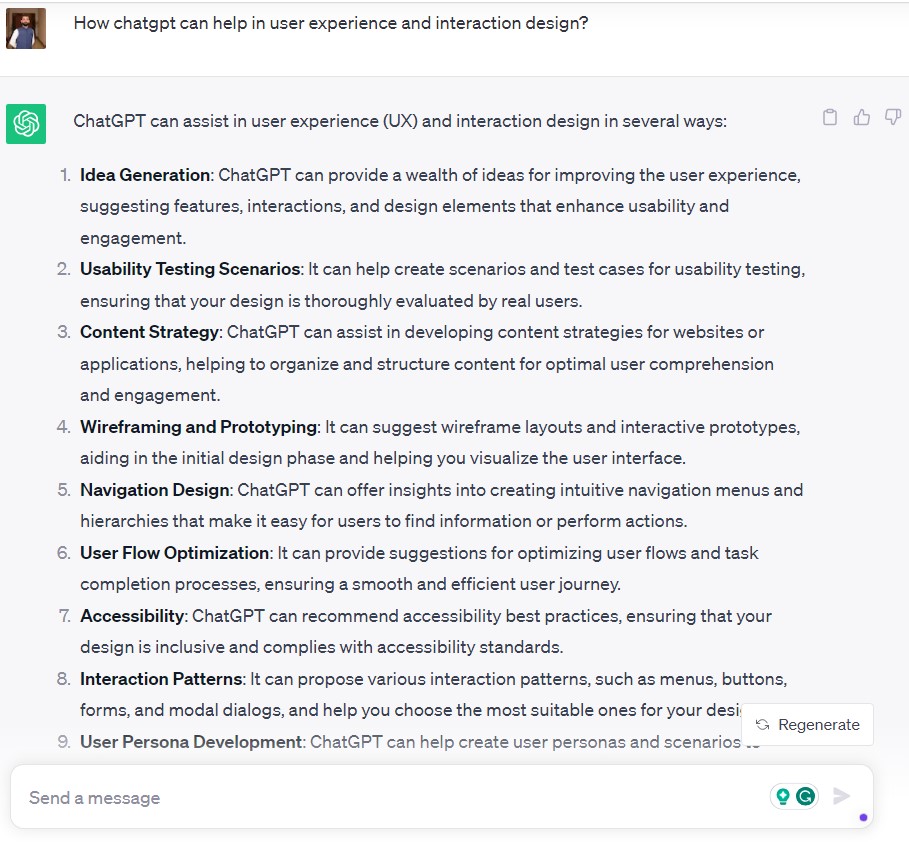
Cultural and Societal Context
Graphic design is heavily influenced by cultural and societal contexts. Designers need to understand the cultural nuances and context of a particular region or demographic to create designs that resonate with the target audience.
While ChatGPT can analyze data on cultural and societal trends, it cannot fully replace the human ability to understand and interpret these nuances in a way that is relevant and effective for the design project.
How Graphic Designers Can Use ChatGPT?
ChatGPT can be a powerful tool for graphic designers to enhance their workflow and create faster and better designs. Let’s explore how graphic designers can use ChatGPT to improve their design process:
Generate Ideas and Inspiration
ChatGPT can be used to generate ideas and inspiration for a design project. Designers can input keywords or phrases related to the project and let ChatGPT generate ideas based on data analysis. This can help designers come up with new and innovative ideas that they may not have thought of otherwise.
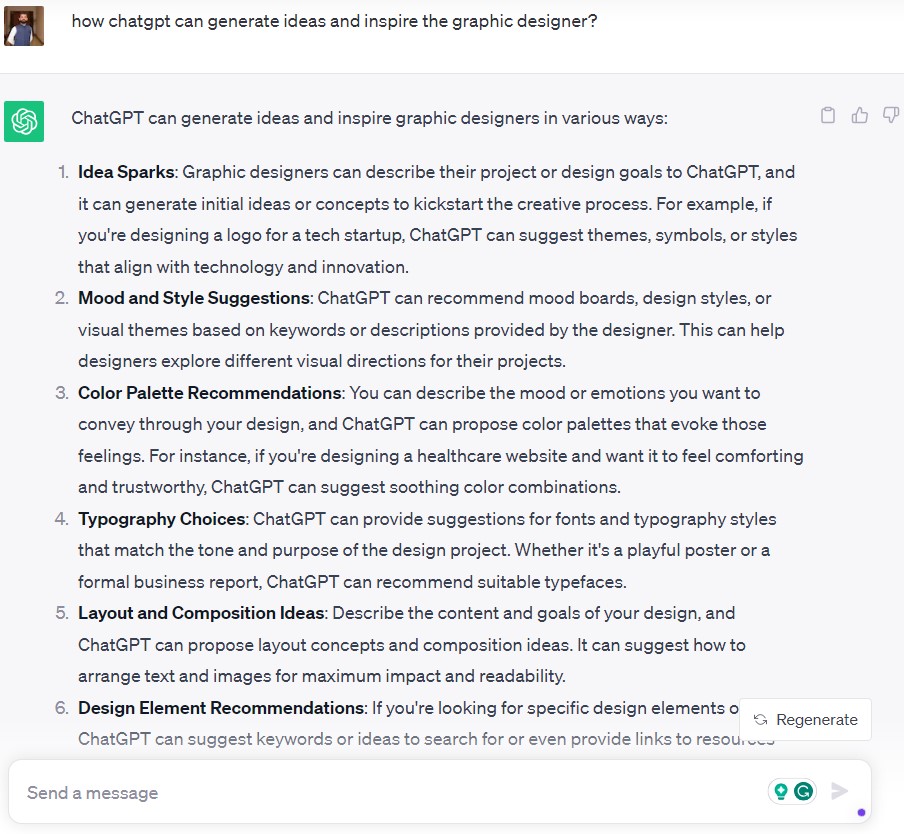
Automate Repetitive Tasks
ChatGPT can be used to automate repetitive tasks such as resizing images or generating variations of a design. This can save designers a significant amount of time and allow them to focus on more creative aspects of the design process.
Generate Copy and Headlines
ChatGPT can be used to generate copy and headlines for a design project. Designers can input a brief or keywords related to the project, and ChatGPT can generate multiple variations of copy and headlines based on data analysis.
This can help designers save time and ensure that their copy and headlines are optimized for their target audience.
Enhance Design Aesthetics
ChatGPT can be used to enhance design aesthetics by suggesting color palettes, font combinations, and image styles based on data analysis.
Designers can input keywords or phrases related to the project. ChatGPT can generate multiple variations of color palettes, font combinations, and image styles. This can help designers ensure that their designs are visually appealing and effective for their target audience. Let’s find it from ChatGPT how it can help in enhancing design aesthetics:

Analyze User Data
ChatGPT can analyze user data and provide insights into user behavior. Designers can input data related to user behavior on a website or app, and ChatGPT can provide insights into user behavior, such as which pages are most visited or which features are most used.
This can help designers optimize their designs for user experience and ensure that their designs are effective for their target audience.
FAQs
Is AI Going to Replace Graphic Designers?
While AI and ChatGPT can automate certain aspects of the design process, they cannot replace the creativity and problem-solving skills that graphic designers bring to a project.
Graphic designers will still be needed to ideate, strategize, and bring a unique perspective to their designs.
Will ChatGPT Replace Content Designers?
ChatGPT can assist content designers by generating ideas and automating certain tasks, but it cannot replace their expertise in creating compelling and effective content.
Content designers will still be needed to develop messaging strategies and craft content that resonates with their target audience.
Will ChatGPT Replace UX Designers?
ChatGPT can aid UX designers in gathering user data and generating design ideas, but it cannot replace the human intuition and empathy that UX designers bring to the design process.
UX designers will still be needed to understand user needs and create user-centric designs that solve problems and improve experiences.
Will ChatGPT Replace UI Designers?
ChatGPT can assist UI designers in generating design ideas and automating certain tasks, but it cannot replace their expertise in creating visually appealing and user-friendly interfaces.
UI designers will still be needed to develop intuitive and effective interface designs that meet user needs and business goals.
Will ChatGPT Replace Product Designers?
ChatGPT can aid product designers in generating design ideas and automating certain tasks, but it cannot replace their expertise in creating products that meet user needs and solve complex problems.
Product designers will still be needed to understand user needs and business goals and create innovative and effective solutions.
Can ChatGPT Replace Creative Jobs?
While ChatGPT can assist with certain tasks, it cannot replace the creativity, intuition, and problem-solving skills that are integral to creative jobs. Creative jobs will still require human expertise to bring unique perspectives and ideas to a project.
Will ChatGPT Take My Design Job?
While ChatGPT can assist with certain tasks, it cannot replace the creativity, intuition, and problem-solving skills that are integral to creative jobs.
Creative jobs will still require human expertise to bring unique perspectives and ideas to a project.